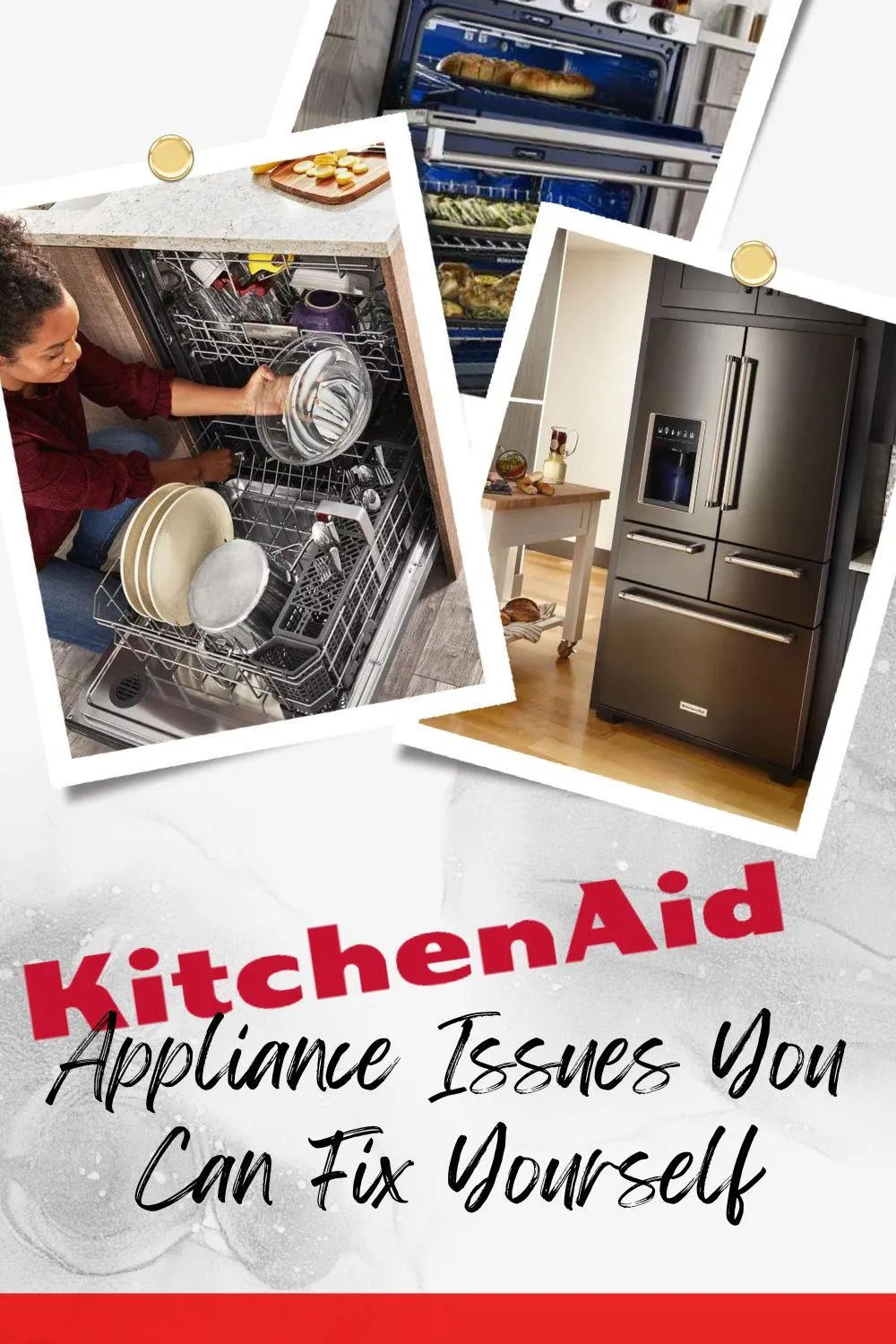
Essential Guide to KitchenAid Appliance Issues
"Master your kitchen with our Essential Guide to KitchenAid Appliance Issues—your go-to resource for keeping your appliances running smoothly and efficiently." - Appliance Boss
Introduction
Welcome to Your Ultimate KitchenAid Troubleshooting Guide
KitchenAid appliances are a beloved staple in many kitchens, renowned for their durability and performance. However, even the most reliable appliances can encounter issues. This comprehensive guide aims to empower you with the knowledge to troubleshoot common KitchenAid appliance problems, ensuring your kitchen runs smoothly and efficiently.
Why Knowing Common Issues Can Save You Time and Money
Understanding and identifying common appliance issues can prevent minor problems from escalating into costly repairs. With the right know-how, you can often resolve these issues yourself, saving both time and money. Additionally, regular maintenance can extend the lifespan of your appliances, providing you with years of reliable service.

Understanding KitchenAid Appliances
Overview of Popular KitchenAid Appliances
KitchenAid offers a wide range of appliances, each designed to make kitchen tasks easier. Popular products include stand mixers, refrigerators, dishwashers, ovens, ranges, and microwaves. Each appliance is engineered to deliver exceptional performance, whether you’re whipping up a batch of cookies, storing fresh produce, or preparing a gourmet meal.
How KitchenAid Appliances Work
KitchenAid appliances are built with precision engineering and advanced technology. Understanding the basic mechanics of these appliances can help you troubleshoot issues more effectively. For example, stand mixers use a powerful motor to drive a planetary mixing action, while refrigerators rely on a compressor to maintain optimal cooling temperatures.
Common KitchenAid Mixer Issues
Motor Malfunctions: Causes and Fixes
The motor is the heart of your KitchenAid mixer. Over time, it can experience wear and tear, leading to malfunctions. Common causes include overloading the mixer or using it for extended periods without breaks. To fix motor issues, start by checking the power source and resetting the motor. If the problem persists, you may need to replace the motor or seek professional repair services.
Dealing with Worn-Out Gears
Heavy use can cause the gears in your mixer to wear out, resulting in a loss of efficiency or complete failure. To address this, you can replace the worn gears with new ones. Ensure you follow the manufacturer’s instructions carefully or consult a professional if you’re not confident in performing the repair yourself.
Speed Control Problems and Solutions
If your mixer is operating at inconsistent speeds, the speed control mechanism might be faulty. This issue can often be resolved by adjusting the speed control settings or replacing the control board. Regularly cleaning the mixer and avoiding overloading it can also help prevent speed control problems.
KitchenAid Refrigerator Problems
Not Cooling: Troubleshooting Tips
A refrigerator that isn’t cooling properly can lead to spoiled food and frustration. Start by checking the thermostat settings and ensuring the condenser coils are clean. If the problem persists, inspect the door seals for leaks and consider replacing the thermostat or compressor.
Fixing Water Dispenser Issues
Water dispensers can stop working due to clogged filters, faulty inlet valves, or frozen water lines. Begin by replacing the water filter and checking the water supply line. If these steps don’t resolve the issue, you may need to replace the inlet valve or defrost the water line.
Addressing Ice Maker Malfunctions
Ice maker problems can stem from a variety of causes, including clogged water filters, defective water inlet valves, or malfunctioning ice maker assemblies. To troubleshoot, start by replacing the water filter and checking the water supply line. If the issue persists, inspect the ice maker assembly and replace any faulty components.
KitchenAid Dishwasher Troubles
Poor Cleaning Performance: Diagnosing the Cause
If your dishwasher isn’t cleaning dishes effectively, the issue could be due to clogged spray arms, a malfunctioning detergent dispenser, or a worn-out pump. Clean the spray arms regularly, ensure the detergent dispenser is functioning correctly, and replace the pump if necessary.
Solving Drainage Problems
Drainage issues can cause water to pool at the bottom of your dishwasher. Check the drain hose for clogs and ensure it’s properly connected. Additionally, inspect the drain pump and clean or replace it if it’s not working correctly.
Dealing with Unusual Noises
Unusual noises during a dishwasher cycle can indicate problems with the motor, pump, or spray arms. Inspect these components for wear and tear, and replace any damaged parts. Regular maintenance, such as cleaning the filter and spray arms, can also help prevent noise issues.
KitchenAid Oven and Range Challenges
Uneven Heating: Common Causes and Fixes
Uneven heating in your oven can result in poorly cooked meals. Common causes include a faulty heating element, a malfunctioning thermostat, or poor insulation. To fix this, replace the heating element or thermostat and check the oven’s insulation for any gaps or damage.
Solving Ignition Problems
Ignition problems in gas ovens and ranges can prevent your appliance from heating up. Check the igniter for wear and replace it if necessary. Additionally, ensure the gas supply is connected and functioning properly.
Oven Door Not Closing Properly
An oven door that doesn’t close properly can lead to heat loss and inefficient cooking. Inspect the door hinges and seals for damage and replace them if needed. Regularly cleaning the door seals can also help maintain a proper seal.
KitchenAid Microwave Issues
Microwave Not Heating: What to Check
If your microwave isn’t heating, the problem could be due to a faulty magnetron, capacitor, or diode. Check these components for damage and replace them if necessary. Additionally, ensure the door switch is functioning correctly, as a faulty switch can prevent the microwave from operating.
Handling Door Switch Failures
Door switch failures can prevent your microwave from turning on. Inspect the door switch for wear and replace it if needed. Regularly cleaning the door switch can also help maintain its functionality.
Dealing with Strange Odors and Sounds
Strange odors and sounds from your microwave can indicate food buildup or electrical issues. Clean the microwave thoroughly to remove any food debris and inspect the electrical components for damage. If the problem persists, consider seeking professional repair services.
Preventative Maintenance for KitchenAid Appliances
Regular Cleaning Tips for Optimal Performance
Regular cleaning is essential to keep your KitchenAid appliances running smoothly. For mixers, clean the attachments and bowl after each use. For refrigerators, clean the condenser coils and shelves regularly. Dishwashers and ovens also benefit from routine cleaning to prevent buildup and maintain efficiency.
How to Perform Routine Inspections
Routine inspections can help identify potential issues before they become major problems. Check for loose or worn parts, leaks, and unusual noises. Regularly inspect the electrical components and connections for any signs of damage.
When to Replace Parts Before They Fail
Replacing parts before they fail can prevent downtime and costly repairs. Monitor the condition of critical components, such as motors, gears, and heating elements, and replace them if they show signs of wear. Keeping spare parts on hand can also help you address issues promptly.
DIY Fixes vs. Professional Repairs
Simple Fixes You Can Do at Home
Many common KitchenAid appliance issues can be fixed at home with basic tools and knowledge. Simple fixes include replacing water filters, cleaning condenser coils, and tightening loose parts. Always follow the manufacturer’s instructions and safety guidelines when performing DIY repairs.
Knowing When to Call a Professional
While DIY repairs can save money, some issues require professional expertise. Complex problems, such as electrical malfunctions or major component failures, should be handled by a qualified technician. If you’re unsure about a repair, it’s best to call a professional to avoid causing further damage.
Finding Reliable Repair Services
Finding a reliable repair service is crucial for ensuring your KitchenAid appliances are fixed correctly. Look for repair technicians who are certified and experienced with KitchenAid products. Reading customer reviews and asking for recommendations can also help you find trustworthy repair services.
Tips for Extending the Life of Your KitchenAid Appliances
Best Practices for Daily Use
Proper usage can extend the life of your KitchenAid appliances. Avoid overloading your mixer or dishwasher, and use the recommended settings for each appliance. Follow the manufacturer’s guidelines for usage and maintenance to prevent unnecessary wear and tear.
Long-Term Maintenance Strategies
Long-term maintenance is key to keeping your appliances in top condition. Schedule regular professional inspections and cleanings, and replace worn parts promptly. Store appliances properly when not in use to protect them from dust and damage.
Common Mistakes to Avoid
Avoid common mistakes that can shorten the lifespan of your appliances. These include using the wrong cleaning products, neglecting regular maintenance, and overloading appliances. Educate yourself on the proper care and usage of each appliance to prevent these mistakes.
Understanding KitchenAid Warranty and Support
What Your Warranty Covers
Understanding your KitchenAid warranty can help you know what repairs and replacements are covered. Most warranties cover defects in materials and workmanship for a specified period. Read the warranty terms carefully to understand what is and isn’t covered.
How to Make a Warranty Claim
Making a warranty claim involves contacting KitchenAid customer support and providing proof of purchase. Be prepared to describe the issue in detail and follow the instructions provided by the support team. Keep all receipts and warranty documents for reference.
Accessing KitchenAid Customer Support
KitchenAid offers customer support to help with troubleshooting and repairs. You can contact support via phone, email, or online chat. The KitchenAid website also offers resources such as user manuals, FAQs, and instructional videos to assist with common issues.
Frequently Asked Questions
Quick Answers to Common Concerns
Get quick answers to common concerns about KitchenAid appliances. Learn how to reset your mixer, troubleshoot cooling issues in your refrigerator, and more. These quick tips can help you resolve minor problems efficiently.
Troubleshooting Tips from the Pros
Professional technicians offer valuable troubleshooting tips for KitchenAid appliances. Learn how to diagnose issues accurately and implement effective solutions. These expert tips can save you time and frustration.
Conclusion
Recap of Key Points
In summary, understanding and addressing common KitchenAid appliance issues can save you time, money, and hassle. Regular maintenance and proper usage are crucial for keeping your appliances in optimal condition. Know when to perform DIY repairs and when to call a professional for help.
Encouragement for DIY Enthusiasts
Don’t be intimidated by appliance issues. With the right knowledge and tools, many problems can be resolved at home. Empower yourself with the skills to troubleshoot and fix common issues, and enjoy the satisfaction of maintaining your KitchenAid appliances.
Final Tips for Keeping Your KitchenAid Appliances in Top Shape
Keep your KitchenAid appliances running smoothly with regular cleaning, routine inspections, and timely part replacements. Stay informed about common issues and solutions, and don’t hesitate to seek professional help when needed. For expert repair services, contact Zip Appliance and Plumbing Repair at www.ziprepairservice.com or call us at (661) 387-2282. Your kitchen will thank you for the care and attention!
